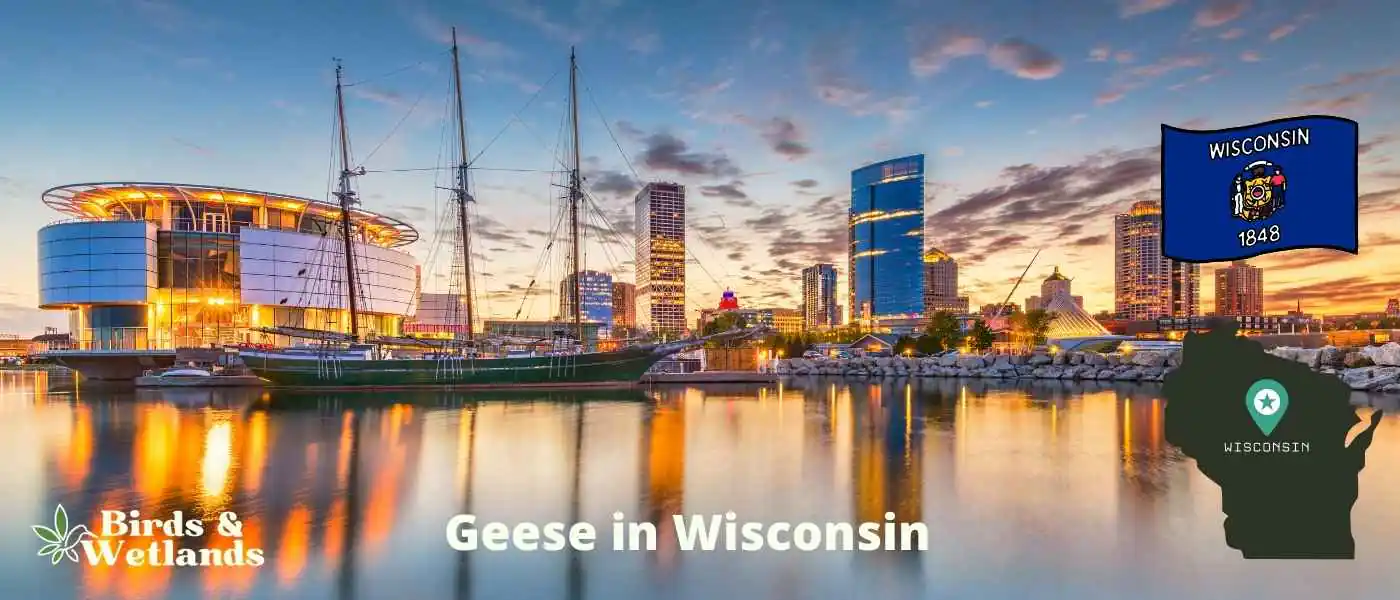Wisconsin is a beautiful little state, and this makes it an ideal destination for nature lovers, vacationers, and lovers of all things cheese.
Despite its charming locale, the state doesn’t have the most diverse wildlife variety.
Thankfully, there are several types of geese found in Wisconsin that offer a unique identity to those searching in the area.
What Geese Are in Wisconsin?
There are five different types of geese in the state of Wisconsin.
- Canada Goose
- Snow Goose
- Ross’s Goose
- Cackling Goose
- Greater White-Fronted Goose
Additionally, there are three types of swans in Wisconsin – Tundra Swans, Trumpeter Swans and Mute Swans.
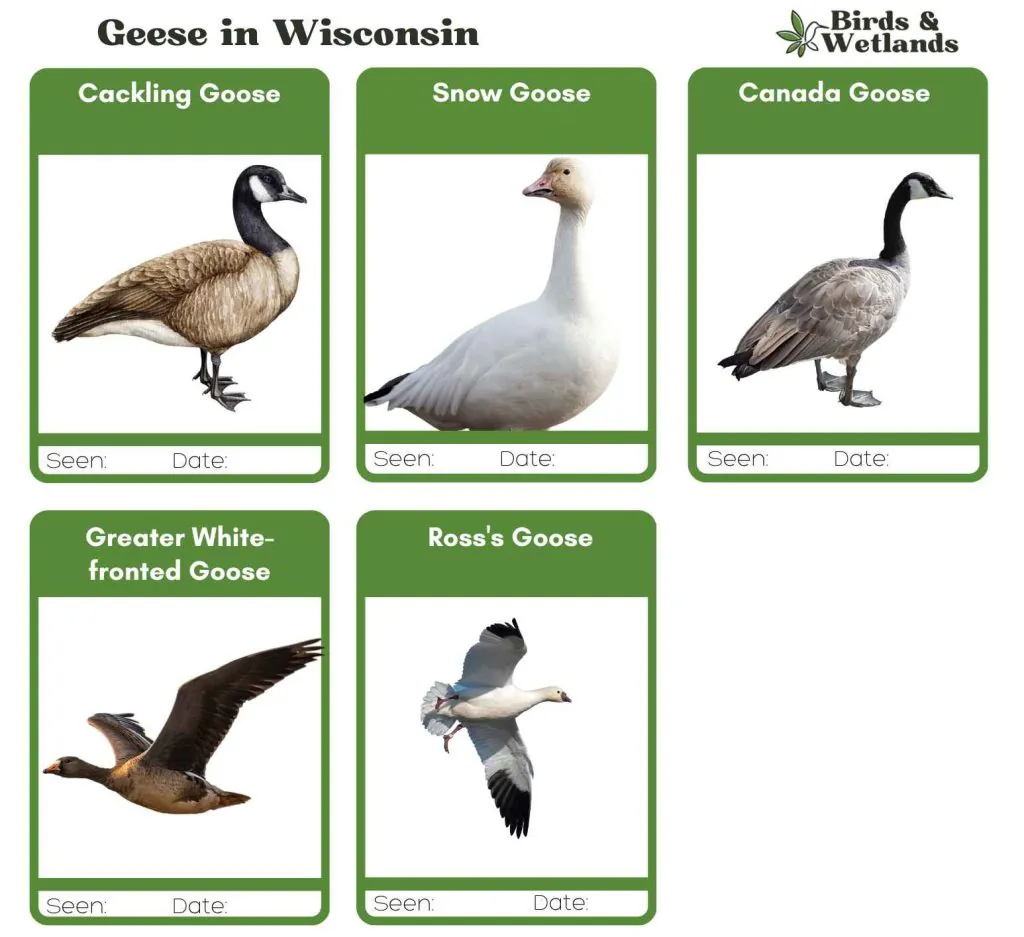
Canada Goose
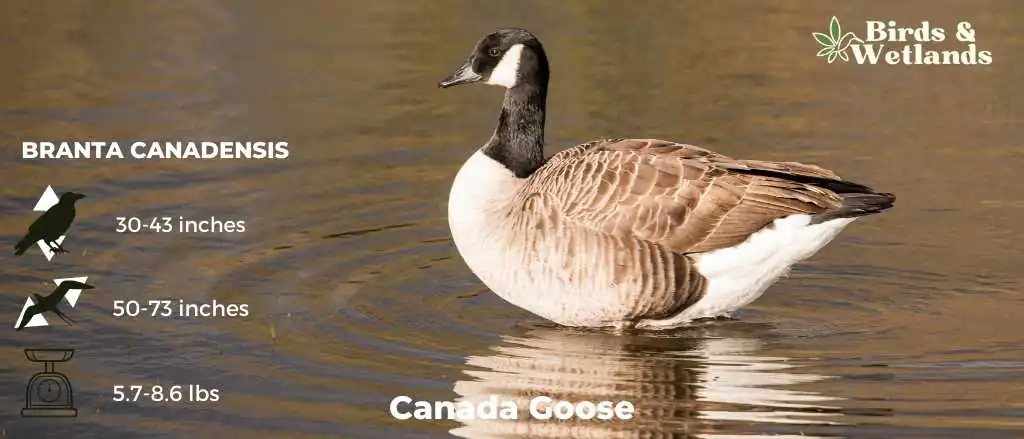
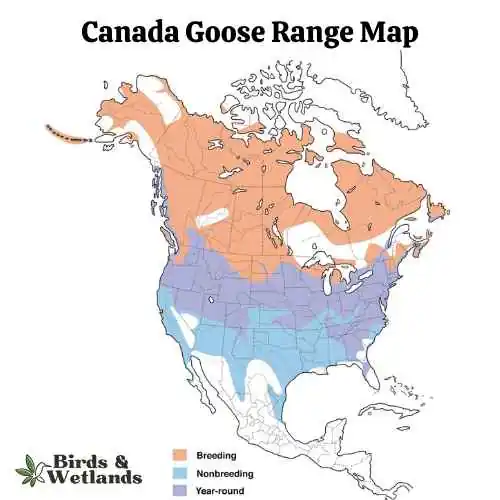
Canada Goose Sound
Scientific Name: Branta canadensis
Length: 30 to 43 in
Wingspan: 50–73 in
Weight: 5.7–14.3 lb
The Canada Goose is a large, well-known species of waterfowl noted for its distinctive appearance, familiar “honk,” and migratory behavior.
Appearance: Both male and female Canada Geese have a similar appearance, featuring a black head and neck with distinctive white patches on the cheeks and chin. The body is primarily brown with a lighter, often white, underbelly.
Diet: Canada Geese primarily feed on plant matter, including grasses, aquatic vegetation, and grains. They can often be seen grazing in parks, lawns, and fields, as well as dabbling in water bodies.
Reproduction: Canada Geese typically nest on the ground near water bodies, often on islands or other isolated areas to avoid predators. The female lays a clutch of about 4 to 6 eggs, which she incubates alone for around a month.
Snow Goose
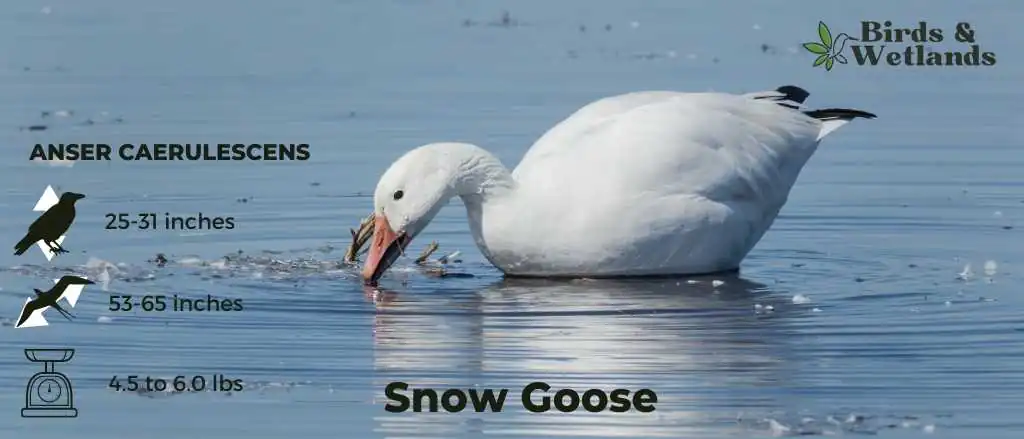
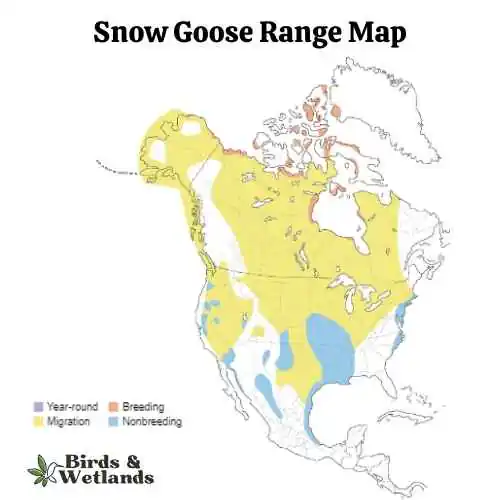
Snow Goose Sound
Scientific Name: Anser caerulescens
Length: 25 to 31 in
Wingspan: 53 to 65 in
Weight: 4.5 to 6.0
The Snow Goose is a large species of waterfowl known for its vibrant white plumage and significant migratory flights.
Appearance: True to their name, Snow Geese are predominantly white with black wingtips. They also have a pink bill, pink legs and feet. A color morph, known as the “Blue Goose,” displays a bluish-gray body with a white head, but is considered the same species.
Diet: Snow Geese primarily feed on plant matter, such as grasses, sedges, and small grains. They can often be seen in large flocks foraging in fields and marshes, and during migration and winter, they can cause considerable damage to agricultural fields due to their feeding habits.
Reproduction: Snow Geese typically nest on the tundra, near water bodies. The female builds the nest and lays a clutch of about 3 to 5 eggs, which she incubates alone for approximately three weeks. Once hatched, the goslings can feed themselves but stay with their parents for protection until they can fly.
Ross’s Goose
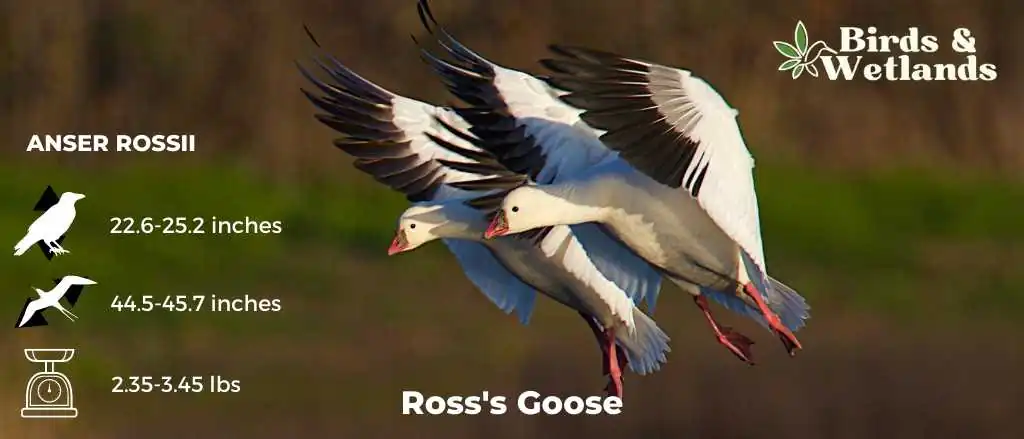
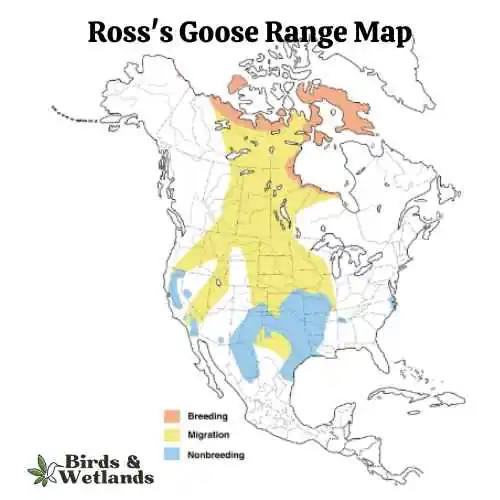
Listen
Scientific Name: Anser rossii
Length: 23.2-25.2
Wingspan: 44.5-45.7 in
Weight:42.3-55.3 oz
The Ross’s Goose is a small species of waterfowl often found in North America’s tundra and wetland habitats.
Appearance: Known for its compact size, the Ross’s Goose is mostly white with black wingtips. It features a short, stubby bill and a rounded head. One key identifying feature is the blueish gray base of its bill, which has a warty structure during the breeding season.
Diet: This goose feeds mainly on vegetation, including seeds, leaves, and roots of grasses and sedges. During winter and migration, they also consume grains and seeds from agricultural fields.
Reproduction: The Ross’s Goose nests on the ground, often in colonies. The female lays a clutch of 2 to 5 eggs which she incubates for around three weeks. The young geese, known as goslings, are precocial – they can walk, swim, and feed themselves shortly after hatching, although they stay with their parents until they learn to fly.
Cackling Goose
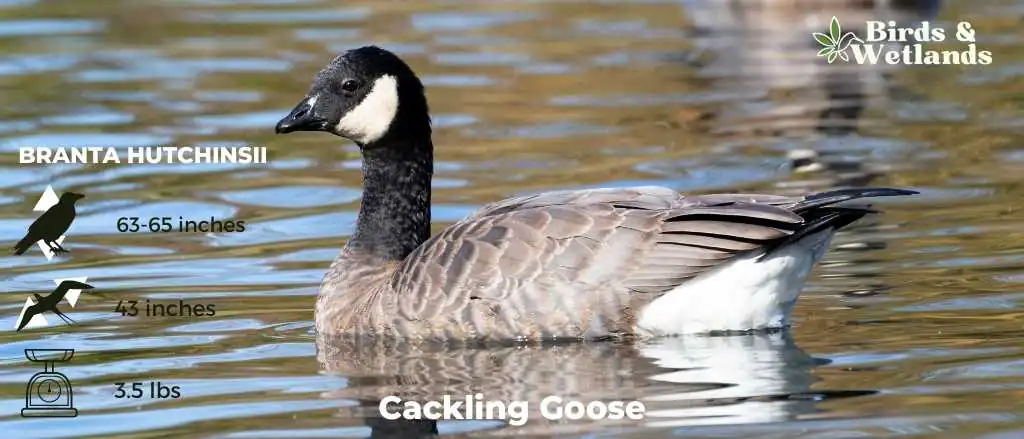
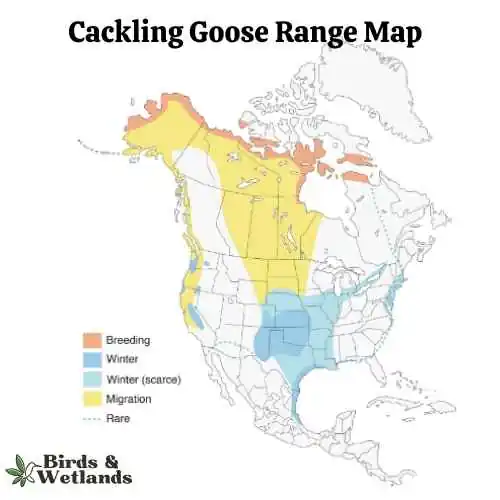
Listen
Scientific Name: Branta hutchinsii
Length: 24.8–25.6 in
Wingspan: 43-45.7 in
Weight:3.5 lbs
Cackling Geese are particularly known for their high-pitched, cackling calls, which is the source of their name. Despite their small size, these geese are renowned long-distance migrants, with some populations traveling thousands of miles between breeding and wintering grounds.
Appearance: With a similar color pattern to the larger Canada Goose, the Cackling Goose features a black head and neck, white chinstrap, light tan to cream chest, and brownish-grey body. One defining characteristic is its noticeably smaller size and stubbier neck compared to its larger counterparts.
Diet: Like many geese, the Cackling Goose’s diet mainly consists of plant matter. This includes grasses, seeds, and aquatic vegetation. They are often seen grazing on land or dabbling in shallow water.
Reproduction: Cackling Geese usually nest on the ground in elevated areas near water bodies, such as riverbanks or lakeshores. The female lays a clutch of 2 to 8 eggs and is responsible for incubation, while the male stands guard nearby. Incubation lasts for about a month.
Greater White-fronted Goose
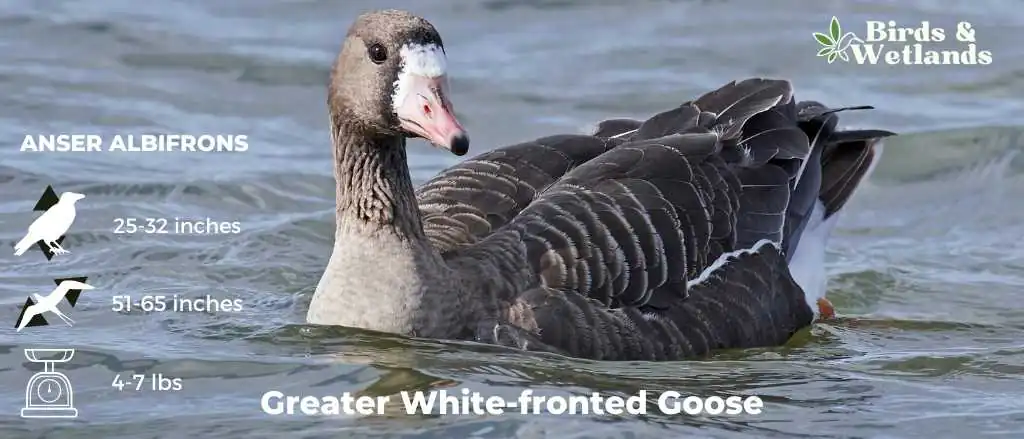
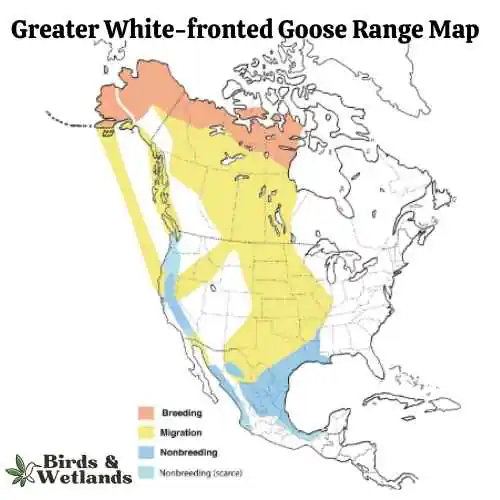
Listen
Scientific Name: Anser albifrons
Length: 25 to 31 in
Wingspan: 53 to 66 in
Weight: 3.3 to 6.6
The Greater White-fronted Goose is a medium to large waterfowl species, widely distributed across the Northern Hemisphere, particularly in North America.
Appearance: As the name suggests, these geese display a prominent white patch at the base of their bill. Their bodies are gray-brown, and their breasts are often marked with dark blotches. They possess a pinkish bill and orange legs and feet.
Diet: The Greater White-fronted Goose is a herbivore and feeds mainly on plant material. Its diet consists of grasses, sedges, grains, and berries. When wintering, these geese can often be found in agricultural fields, feasting on leftover grains and crops.
Reproduction: This species nests on the ground, often in areas with good visibility such as slopes or ridges. The female lays a clutch of 4 to 5 eggs, which she incubates for nearly a month. Once hatched, the young ones are taken care of by both parents until they are able to fly.
Where to Watch Geese and Other Waterfowl in Wisconsin?
Wisconsin is well-known for its abundance of natural beauty, and its numerous lakes and wetlands are a big part of that.
If you’re looking to explore the state’s waterfowl population, there are a few great places to start. Horicon Marsh is one of the largest freshwater marshes in the United States, is along the Mississippi River flyway and it’s home to a wide variety of birds, including (Mississippi Valley Population) MVP geese, ducks, herons, and cranes.
MVP geese select their nesting grounds in along the western shores of James Bay and the southern edge of Hudson Bay.
Moreover, many wintering geese spend time during fall migration in southern Wisconsin from their breeding grounds in the north.
Some snow and blue geese use the Horicon zone as a stopover before their head to their final wintering grounds in southern Illinois, Western Kentucky and Tennessee.
In east central Wisconsin, you’ll find Rock Island Woods State Natural Area, which is a popular spot for watching migrating waterfowl.
And if you venture into the state’s interior, you’ll find many small lakes that are teeming with waterfowl.
Are There Any Resident Geese Flocks In Wisconsin?
Wisconsin does have resident Canada geese.
These geese are part of the Mississippi Valley Population (MVP).
This is a group of geese that flies exclusively from Canada through Wisconsin along the Mississippi River flyway, which includes Horicon Marsh and other south-eastern Wisconsin refuges.
The species most often settling in Wisconsin all year round is the giant Canada goose.
Local breeding population of giant Canada geese are often found in areas with access to water, such as lakes, rivers, golf courses and wetlands.
In the winter, large flocks are sighted in open spots in fields and parks where they can find food such as aquatic vegetation.
Geese Hunting in Wisconsin
Hunting is a popular pastime in Wisconsin, and there are many different types of game that can be hunted in the state.
In order to hunt geese in Wisconsin, hunters must have a small game license as well as a Wisconsin Waterfowl stamp.
In addition, if they are hunting Canadian geese, they must also have a Canadian Goose Permit. These permits can be obtained from the Wisconsin Department of Natural Resources.
Can You Shoot a Goose in Wisconsin?
Yes! When choosing a hunting method, it is important to keep in mind that only non-toxic sizes BB, BBB, T or smaller are legal. With this in mind, hunters should have no trouble finding a hunting method that works for them.
Additionally, you should be familiar with Wisconsin’s daily bag and possession limits for waterfowl during the goose hunting season which takes place from September to January.
Where Can I Hunt Geese in Wisconsin?
There are a couple of different areas where you can find geese in Wisconsin.
One place fields around southeastern Wisconsin.
Another place is the state area of the Horicon Marsh.
You can’t hunt in the northern portion of Horicon Marsh though because it’s owned by the federal government and is known as the Horicon National Wildlife Refuge or federal refuge.
Waterfowl hunting is only allowed in the state area of the Horicon Marsh.
Conclusion on Geese in Wisconsin
While there are only three types of swans in Wisconsin, the state is home to five different types of geese.
If you’re ever in the area and want to see some beautiful birds, be sure to check out a local park or lake!

